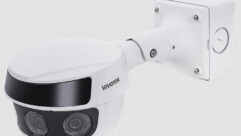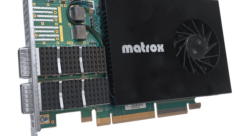
On the Network
Aug 18, 2010 11:19 AM,
By Cynthia Wisehart
Residential AV helps set the new bar for commercial AV.

There was a time when the out-of-home AV experience could pretty easily trump what people had in their home systems, if they even had a home system. But now, just as with home-based IT, residential AV and control systems reflect what goes on in work and entertainment spaces and vice versa. Everybody’s an end-user now, even at home.
End-users want networks that talk to each other and networks they can access remotely and control from a web-based or phone-based graphical user interface (GUI). Increasingly, they don’t want borders between AV, HVAC, lighting, IT, the phone, and video chat. At the same time, realistically, we know that the kind of reliability that’s expected from commercial AV environment still demands best-in-class proprietary elements. This is not to say that we wave a magic iPhone and the LAN is king. Far from it, in fact.
But it is not so far away that we can wait to think in new ways. This is a cultural and generational shift as well as a technological one. And as has been proven by digital video and audio production, consumer and commercial do converge—exponentially in fact, aided among other things by Moore’s Law. So while we are truthfully steering today’s customer toward the proven and the bulletproof, we must steer ourselves toward the horizon.
This is necessary as stewards of both our businesses and our customers’ needs, and of our industry. Today’s customer is increasingly influenced by technical systems engineers—whether AV, IT, low-voltage, electrical, automation, or telephony—who have his ear and a case to make.
We are entering a new time in AV when control will truly be the heart of the value proposition—it will drive sales and design. Customers’ expectations will be influenced by their experience and interactions with the many networks and providers in their lives. Our ability to deliver quality aural and visual images will certainly set us apart from all the other kinds of systems engineers who are talking to our customers. Those other engineers don’t know what we know. But will that be enough? Everyone will be speaking the language of centralized control from their own viewpoint and vocabulary. How will the AV industry lead this discussion to the mutual benefit of our customers and our industry?
I checked in with three companies with a certain expertise in controlling AV networks. With their knowledge of both the residential and commercial worlds, I asked them where they think this is all going and how they plan to help us all compete in the new world of integrated systems.
On the Network
Aug 18, 2010 11:19 AM,
By Cynthia Wisehart
Residential AV helps set the new bar for commercial AV.

At InfoComm, Crestron released its new MC3 controller, a product that was inspired by the IT paradigm.
Crestron
“There was a time in the early days of residential systems when corporate executives would want to have things they had in their boardroom systems in their homes,” says Crestron’s Jeffrey Singer, recalling how commercial AV products would often migrate into designer cabinets in high-end houses, which were essentially small facilities. “Today it’s the opposite. We see the consumer market driving the commercial, with HD, mobile devices, Blu-ray, Roku, Blackberry, iPhone … and the question becomes, ‘Why can’t I do that at work?’” The answer, of course, is scale—number of users, distances, distribution, space, reliability, security, and more. “But it’s become the new bar: Why does my system at home look better and work better than my system at work?”
“There’s another trend that’s coming out of residential, or at least in a grassroots way from individuals, and that’s the green movement,” Singer says. He sees continued opportunity for AV control systems, which have for some time handled environmental and energy elements such as lighting and HVAC monitoring, device on/off, and maintenance feedback tasks. Crestron is pursuing this trend in a very tangible way through new control products for shades and daylight harvesting that will extend to Crestron’s plans to manufacture the shades themselves.
“Both in terms of controlling the media systems and the environmental systems, people increasingly think of it as a total package, and they want to be able to control it that way. These systems used to exist in silos, but now they need to cross-communicate,” Singer says. This has not been lost on IT and building automation engineers and manufacturers. “They don’t really know yet how to handle all the content, streaming media, videoconferencing—knowing how to monitor when a room is occupied, how to schedule it, what input is being used by the projector—but one day they may. I think that’s a natural progression. We’re all serving the same clients, looking at the same spaces. Like three hungry dogs looking at the same bone,” he says with a half-smile in his voice.
The urgency of integrated systems has been driving development at Crestron for some time both collaboratively and competitively. For example, the new release of Crestron’s RoomView management and monitoring software has elements co-developed with Microsoft to allow interaction with Outlook; likewise, the new release of Outlook integrates RoomView as a native part of the program.
Even more ambitiously, the IT paradigm also inspired the new MC3 controller that Crestron released at InfoComm. It’s the first product to be built on Crestron’s new Power of Three platform, which Singer analogizes to a computer operating system. “It’s fundamentally different than any other control system in our industry,” he says. “It’s built like an IT server—where it is divided into modules, partitions, with multiple layers of redundancy.” This architecture is intended to enable a centralized backbone that integrates AV, environmental systems, and global enterprise management on a single platform. The various functionalities will be served by software—first a rewritten RoomView and later this year the Veridian environmental control software to control and monitor lighting and temperature. Future software modules are in development for digital signage, content capture, management and distribution, and IT network functions such as printer and copier control. These software modules will come together under a central server application called Fusion. “So think of Fusion as the front end, supporting modules for various functions, and then the Power of Three platform is the back end that supplies the memory and network connectivity to support this level of cross-communication,” Singer says.
To learn more about how to factor Crestron’s AV ecosystem into your design, a call to the Tech Sales department is free and consultants will walk you through the concepts and roadmap for the Power of Three and Fusion. Additionally, consider gaining your certification in Crestron’s Digital Media, the company’s solution for HD AV distribution and control, through the one-day design certification or the three-day engineering certification (both now accredited by InfoComm and CEDIA). Understanding Crestron’s approach to moving digital files and signal is a entry point to understanding how the company thinks about digital networks that integrate AV and other building systems.
On the Network
Aug 18, 2010 11:19 AM,
By Cynthia Wisehart
Residential AV helps set the new bar for commercial AV.

Incorporating customer feedback, Extron Electronics created Global Configurator 4. The software extends Extron’s TouchLink system templates to encompass a wider range of Ethernet-controllable devices, including IP-linked control processors, matrix switchers, and more.
Extron Electronics
Derek Joncas is Extron’s manager of product marketing for control systems hardware and software, and as such he does a lot of customer education and outreach. He describes how at training sessions, he has been amazed to see the comfort level so many people have with their handheld devices. He agrees that lifestyle devices are helping to drive the growth and maturation of IP-based control systems.
A bellwether for Extron, he says, has been the recent release of the Software Roadmap, available on the company’s website. This roadmap works in conjunction with Extron’s commitment to configurable control that lays out an increasingly transparent course for the future.
For Extron, a big part of the future discussion revolves around the potential for configurable control systems to expand into designs that were previously the domain of programming. This approach also draws inspiration from IT and residential trends; people expect the ability to update and reconfigure their simpler devices without having to call a software engineer. As a control programmer, Joncas is a keen advocate for this viewpoint, which does not make programming obsolete by any means but which issues an important challenge: How accessible can we make control, and how can we tie it into the technology and expectations people have now and will have in the future?
In dialogue with customers and colleagues, Joncas says Extron looks for the balance between giving customers both self-sufficiency and support. One example is the upcoming device driver configurator, which will allow customers to build their own drivers. “Up until now, we’ve used certified drivers,” he says. “If you had a piece of equipment that wasn’t in our database, you’d send it in, we’d write a driver. Well, come the turn of the year, we’re going to allow our customers to create their own drivers that can be configured. That was a major customer request. We understand that adding more features can inadvertently increase complexity. So feedback is key to determining people’s tolerance for risk and pain and whether a feature will empower them or not.”
Likewise, other top customer requests are driving the Extron’s Software Roadmap. “We’ve laid it out. These are the most requested capabilities, and here’s when we plan to introduce these items,” he says.
Among them: the upcoming Global Configurator 4 software due out at year end, which takes the kind of templates Extron has provided for the TouchLink systems and expands it to larger, more complex systems that encompass a wider range of Ethernet-controllable devices, including IP-linked control processors and matrix switchers. “The controller grouping capability will allow you to gang many IPLink controllers together and configure—not program—a larger control system,” Joncas says.
Out this month, GUI Configurator 1.1 supports Extron’s move into touchpanels with a software update to allow users to simplify the user interface and pick up on the popularity of the templates and themes the company has already provided on its website.
“We’ve taken a breadcrumb approach, like Amazon, so users can see what they did the last time they were in the program. They can build on what they’ve already made,” he says.
To Joncas, this is all a natural expansion of the now-ubiquitous Ethernet port and Extron’s longstanding web-browser-based control options.
“Eight years ago, it was a luxury to have an Ethernet network. It was a luxury to have the IT department’s cooperation to understand that it was OK for AV devices to live on the network and that there are productivity gains that can be achieved by having them there,” Joncas says. “Now it’s a convenience and luxury that has grown into a necessity.” Today, Extron’s server-based GlobalViewer Enterprise monitors thousands of devices on a network and interacts with Microsoft Exchange and CollegeNET R25 to support scheduling, monitoring, and reporting that reaches even beyond the AV department. “Anyone who has a business interest in how their facility is being used and operated will need the data,” Joncas says.
“We’re a building-blocks company. We’ve given people steps to grow and enable our control systems to be in situations that might not have been comfortable in the past,” he says. “Our industry is coming up against the expectation that everything is going to be connected and monitored, and that control will be able to reach across platforms. People want to look across their enterprise and see everything.” But, he says, embedded in that paradigm are many smaller problems and opportunities that can be tackled now with an eye to the future.
“AV is part of an environment now,” he says. “One of the things we try to educate about is making good choices, and part of making good choices means understanding that the longevity of a system is measured over a much longer period of time now. It has to be flexible and adaptable to move with the customer as the customer’s business evolves.”
How to get hooked into this future vision? “Call us. We have a team available to answer your questions,” Joncas says. He also points to the Training tab on the Extron website, where there are online courses that can lead to certification. Or not. “You might just take a course in networking,” he says. “Either way, every course you take via Extron at any location is aggregated under your user profile. So even if you are not yet certified, you can demonstrate your investment in training to your clients in one place.”
Extron has a certification path from AV associate up to newer certifications for control associates and the upcoming control specialist kicking off in January. Networking will also factor in the curriculum for the upcoming AV Streaming System Design School.
On the Network
Aug 18, 2010 11:19 AM,
By Cynthia Wisehart
Residential AV helps set the new bar for commercial AV.

Last month, AMX began shipping its AMX HDMI UTPro-0808 matrix switcher. It exemplifies the idea that IT will not supplant AV but rather will connect and complement one another via parallel and intersecting networks.
AMX
“The concept that residential markets adopted more readily than commercial is the idea of whole-home automation, a perspective that the home is a single unit with systems that are knitted together in a seamless fashion. We’re just starting to see the counterpart in commercial AV, which traditionally has been room-centric,” says Joe Andrulis, VP of global marketing for AMX. “Whole-environment automation requires that AV control be more conversant and more interactive with environmental management, security, IT—all of these control islands that are now colliding into a new supercontinent we now refer to as ‘unified control.’”
Andrulis emphasizes that the answer to this is something that is hard for AV professionals to hear: We must give up some control in order to play on the bigger continent and to avoid being marginalized. He says it’s important to laser focus on which problems need to be solved—and can benefit from our expertise—and which problems have already been solved. “The IT world already has long experience in an environment where multiple vendors were sharing the same vague IT space. They’ve spent lots of time trying to figure out how to maintain an open environment but still serve the needs of security, access, and control for the vendors trafficking in that environment,” he says. So as AMX moves into the new paradigm, it is trying not to reinvent what is already solved. An example: tying into the existing Lightweight Directory Access Protocol (LDAP) in programs like Microsoft Exchange, which help manage permissions and access. Scheduling, he says, is another resource that is already in the ecosystem that AV control can intersect with and amplify, if “the AV side can open up our view of the world to integrate into what IT has already established.”
“Traditionally AV and IT have not been part of the same thought process,” he says, “and there are unique skills that exist in each thought process.” But those are rapidly disappearing in a world where the keynote speaker at InfoComm is from Cisco. “The truth of the matter is that the two worlds will collide and AV is not going to absorb IT. That’s just reality. And that’s a good thing. AV can benefit from adopting those things that IT has already solved.” Andrulis says he believes the promise of having a whole building automation system is not far-fetched and that AV has unique value to bring to that vision.
The core of this thinking for AMX is its Resource Management Suite, which is evolving in a way that weaves it more seamlessly into IT standards using a modern scalable and redundant architecture. Further, Andrulis makes the important distinction that AV should be part of a network in which systems can be reached and monitored over the LAN, but not necessarily doing all operations over the LAN. “We have to be cautious about imposing dramatic new loads that are sensitive to performance, moving video traffic and heavy-bandwidth tasks and time-sensitive events over LANs,” he says. While this is theoretically possible, there are aspects that for a long time will be handled more reliably by dedicated fiber and traditional AV formats as they are today.
This kind of hybrid thinking is exemplified in AMX’s new HDMI-UTPro 8×8 matrix switcher, which began shipping last month. It’s a full-matrix switcher delivering eight channels of secure HDMI with HDCP authentication across a network via a single UTP cable. It uses HDBaseT technology from Valens Semiconductor and is a new standard for digital transmission in the UTPro line that allows for very long runs. It also exemplifies the idea that IT will not supplant AV but rather will connect and complement one another via parallel and intersecting networks. “For some time it is not going to be practical to assume that you can collapse all your data and your AV time-sensitive traffic onto the same network,” Andrulis says.
Andrulis urges AV professionals to become part of the conversation during the build process and to become more familiar with IT to understand what linkages are going to be important. “Also to the degree that they can have some appreciation for the way the other systems operate, they can come forward with solutions and talk constructively with their peers in other disciplines,” he says.
He also urges AV pros to zero in on specific customer needs and problems that are here now—for example, using digital signage for mass notification in an emergency. “That’s an integration point that people can get their head around and a need they can understand,” he says.
“We are definitely pushing hard this idea of unified control, and what AV systems will need to look like, and what features they will need to include to support that effectively,” Andrulis says. “The introduction of new competitors into this space is going to have a big effect. It’s going to be very unpredictable and not entirely controllable. We are all going to have to react and respond. But we do not go into that battle unarmed. When it comes to usable control, the AV industry is the expert—not in what’s theoretically possible, and just for the educated few. We have long experience in making highly complex systems truly accessible for the masses.
“We can focus on our unique strength while relinquishing some responsibilities that are best handled by IT. That’s the opportunity, but it’s also the thing that creates heartburn, the feeling that giving up some control feels like giving up all control. But things like scheduling and basic networking connectivity—be happy to give those up. Rejoice! And now focus on the things people really find compelling and distinctive about your solutions. That’s kind of a tough transition, but people won’t keep paying you big dollars for problems that are already solved.”
Andrulis lets working-class philosopher Eric Hoffer sum it up: “‘In times of profound change, the learners inherit the Earth, while the learned find themselves beautifully equipped to deal with a world that no longer exists.’ We have to become learners again, like we were when this industry started.”










